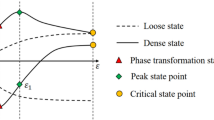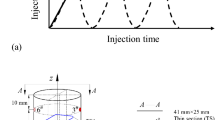Abstract
A stabilized enhanced strain finite element procedure for poromechanics is fully integrated with an elasto-plastic cap model to simulate the hydro-mechanical interactions of fluid-infiltrating porous rocks with associative and non-associative plastic flow. We present a quantitative analysis on how macroscopic plastic volumetric response caused by pore collapse and grain rearrangement affects the seepage of pore fluid, and vice versa. Results of finite element simulations imply that the dissipation of excess pore pressure may significantly affect the stress path and thus alter the volumetric plastic responses.








































Similar content being viewed by others
References
Abellan M-A, de Borst R (2006) Wave propagation and localisation in a softening two-phase medium. Comput Methods Appl Mech Eng 195(37–40):5011–5019
Andrade JE, Borja RI (2006) Capturing strain localization in dense sands with random density. Int J Numer Methods Eng 67(11):1531–1564
Arnold DN (1990) Mixed finite element methods for elliptic problems. Comput Methods Appl Mech Eng 83(1-3):281–312
Babuška I (1973) The finite element method with Lagrangian multipliers. Numerische Mathematik 20:179–192
Bathe K-J (2001) The inf-sup condition and its evaluation for mixed finite element methods. Comput Struct 79(2):243–252
Bear J (1972) Dynamics of fluids in porous media. Elsevier Publishing Company, New York, NY
Belytschko T, Liu WK, Moran B (2000) Nonlinear finite elements for continua and structures. Wiley, West Sussex, England
Biot MA (1941) General theory of three dimensional consolidation. J Appl Phys 12(2):155–164
Bochev PB, Dohrmann CR, Gunzburger MD (2006) Stabilization of low-order mixed finite elements for the Stokes equations. SIAM J Numer Anal 44(1):82–101
Borja RI (2013) Plasticity: Modeling & Computation. Springer, Berlin
Borja RI, Alarcón E (1995) A mathematical framework for finite strain elastoplastic consolidation part 1: Balance laws, variational formulation, and linearization. Comput Methods Appl Mech Eng 122(1–2):145–171
Brezzi F, Douglas J, Marini LD (1985) Two families of mixed finite elements for second order elliptic problems. Numerische Mathematik. 47:217–235
Chapelle D, Bathe KJ (1993) The inf-sup test. Comput Struct 47(4–5):537–545
Coussy O (2004) Poromehcanics. Wiley, West Sussex, England
de Souza Neto EA, Perić D, Owen DRJ (2008) Computational Methods for Plasticity. Wiley, Ltd, ISBN 9780470694626
DiMaggio FL, Sandler IS (1971) Material model for granular soils. J Eng Mech Div 97:935–950
Dolarevic S, Ibrahimbegovic A (2007) A modified three-surface elasto-plastic cap model and its numerical implementation. Comput Struct 85:419–430
Fossum AF, Fredrich JT (2000) Cap plasticity models and compactive and dilatant pre-failure deformation. In: Girard J, Liebman M, Breeds C, Doe T (eds) Pacific rocks 2000: rock around the rim. Seattle, WA, Taylor & Francis pp 1169–1176
Foster CD, Regueiro RA, Fossum AF, Borja RI (2005) Implicit numerical integration of a three-invariant, isotropic/kinematic hardening cap plasticity model for geomaterials. Comput Methods Appl Mech Eng 194:5109–5138
Gamage K, Screaton E, Bekins B, Aiello I (2011) Permeability–porosity relationships of subduction zone sediments. Mar Geol 279(1):19–36
Grueschow E, Rudnicki JW (2005) Elliptic yield cap constitutive modeling for high porosity sandstone. Int J Solids Struct 42:4574–4587
Jeremic B, Cheng Z, Taiebat M, Dafalias Y (2008) Numerical simulation of fully saturated porous materials. Int J Numer Anal Methods Geomech 32(13):1635–1660
Karaoulanis FE (2013) Implicit numerical integration of nonsmooth multisurface yield criteria in the principal stress space. Arch Comput Methods Eng 20:263–308
Ling HI, Liu H (2003) Pressure-level dependency and densification behavior of sand through generalized plasticity model. J Eng Mech 129(8):851–860
Moran B, Ortiz M, Shih CF (1990) Formulation of implicit finite-element methods for multiplicative finite deformation plasticity. Int J Numer Methods Eng. 29(3):483–514
Mota A, Sun W, Ostien JT, Foulk JW, Long KN (2013) Lie-group interpolation and variational recovery for internal variables. Comput Mech (in press)
Nur A, Byerlee JD (1971) An exact effective stress law for elastic deformation of rock with fluids. J Geophys Res 76(26):6414–6419
Prevost JH (1982) Nonlinear transient phenomena in saturated porous media. Comput Methods Appl Mech Eng. 30(1):3–18
Prevost JH, Høeg K (1976) Reanalysis of simple shear soil testing. Can Geotech J 13(4):418–429
Regueiro RA, Foster CD (2011) Bifurcation analysis for a rate-sensitive, non-associative, three-invariant, isotropic/kinematic hardening cap plasticity model for geomaterials: Part I. small strain. Int J Numer Anal Methods Geomech 35:201–225
Rice JR, Cleary MP (1976) Some basic stress diffusion solutions for fluid-saturated elastic porous media with compressible constituents. Rev Geophys 14(2):227–241
Rudnicki JW, Rice JR (1975) Conditions for the localization of deformation in pressure-sensitive dilatant materials. J Mech Phys Solids 23(6):371–394
Sandler IS, Rubin D (1979) An algorithm and a modular subroutine for the cap model. Int J Numer Anal Methods Geomech 3:173–186
Schulze O, Popp T, Kern H (2001) Development of damage and permeability in deforming rock salt. Eng Geol 61(2):163–180
Simo JC, Hughes TJR (1986) On the variational foundations of assumed strain methods. ASME J Appl Mech 53:51–54
Simon BR, Wu JS-S, Zienkiewicz OC, Paul DK (1986) Evaluation of u–w and u − π finite element methods for the dynamic response of saturated porous media using one-dimensional models. Int J Numer Anal Methods Geomech. 10(5):461–482
Skempton AW (1954) The pore-pressure coefficient a and b. Geotechnique 4(4):143–147
Sloan SW, Abbo AJ, Sheng DC (2001) Refined explicit integration of elastoplastic models with automatic error control. Eng Computations 18:121–154
Stefanov YP, Chertov MA, Aidagulov GR, Myasnikov AV (2011) Dynamics of inelastic deformation of porous rocks and formation of localized compaction zones studied by numerical modeling. J Mech Phys Solids 59(11):2323–2340
Stevenson DL (1978) Salem limestone oil and gas production in the Keenville field, Wayne County, Illinois. Department of registration and education, state of Illinois
Sun W (2013) A unified method to predict diffuse and localized instabilities in sands. Geomech Geoeng Int J 8(2):65–75
Sun W, Andrade JE, Rudnicki JW, Eichhubl P (2011) Connecting microstructural attributes and permeability from 3d tomographic images of in situ shear-enhanced compaction bands using multiscale computations. Geophys Res Lett 38(10):L10302
Sun W, Kuhn M, Rudnicki JW (2013a) A multiscale DEM-LBM analysis on permeability evolutions inside a dilatant shear band. Acta Geotech 8:465–480
Sun W, Ostien JT, Salinger A (2013b) A stabilized assumed deformation gradient finite element formulation for strongly coupled poromechanical simulations at finite strain. Int J Numer Anal Methods Geomech. doi:10.1002/nag.2161
Sun WC, Andrade JE, Rudnicki JW (2011) Multiscale method for characterization of porous microstructures and their impact on macroscopic effective permeability. Int J Numer Methods Eng 88(12):1260–1279
Swan CC, Seo YK (2000) A smooth, three-surface elasto-plastic cap model: rate formulation, integration algorithm and tangent operators. Research report, University of Iowa
Terzaghi K, Peck RB, Mesri G (1996) Soil mechanics in engineering practice. Wiley-Interscience, New York, NY
Tu X, Andrade Jose E, Chen Q (2009) Return mapping for nonsmooth and multiscale elastoplasticity. Comput Methods Appl Mech Eng. 198:2286–2296
Van Langen H, Vermeer PA (1991) Interface elements for singular plasticity points. Int J Numer Anal Methods Geomech 15(5):301–315
Wang B, Popescu R, Prevost JH (2004) Effects of boundary conditions and partial drainage on cyclic simple shear test results-a numerical study. Int J Numer Anal Methods Geomech 28(10):1057–1082
White JA, Borja RI (2008) Stabilized low-order finite elements for coupled solid-deformation/fluid-diffusion and their application to fault zone transients. Comput Methods Appl Mech Eng 197(49):4353–4366
Wriggers P (2010) Nonlinear finite element methods. Springer-Verlag, Berlin, Heidelberg
Xia K, Masud A (2006) New stabilized finite element method embedded with a cap model for the analysis of granular materials. J Eng Mech 132(3):250–259
Yang Y, Aplin AC (2007) Permeability and petrophysical properties of 30 natural mudstones. J Geophys Res Solid Earth (1978–2012) 112(B03206):1–14
Zhang HW, Schrefler BA (2001) Uniqueness and localization analysis of elastic plastic saturated porous media. Int J Numer Anal Methods Geomech 25(1):29–48
Acknowledgements
Thanks are due to Professor Bernhard Schrefler for fruitful discussion. We are very grateful for the comprehensive reviews and insightful suggestions provided by the anonymous reviewers. Sandia National Laboratories is a multi-program laboratory managed and operated by Sandia Corporation, a wholly owned subsidiary of Lockheed Martin Corporation, for the US Department of Energy’s National Nuclear Security Administration under contract DE-AC04-94AL85000.
Author information
Authors and Affiliations
Corresponding author
Rights and permissions
About this article
Cite this article
Sun, W., Chen, Q. & Ostien, J.T. Modeling the hydro-mechanical responses of strip and circular punch loadings on water-saturated collapsible geomaterials. Acta Geotech. 9, 903–934 (2014). https://doi.org/10.1007/s11440-013-0276-x
Received:
Accepted:
Published:
Issue Date:
DOI: https://doi.org/10.1007/s11440-013-0276-x




